|
This section contains 998 words (approx. 4 pages at 300 words per page) |

|
The human senses, which include sight, smell, hearing, and balance, develop primarily from the outermost tissue layer (called the ectoderm) during embryogenesis as highly specialized organs. These organs (the eyes, nose, and ear) appear as regions on the surface of the developing embryo called placodes, which are connected to the central nervous system. Placodes can be subdivided into two major groups. Each group has a pre-determined fate in terms of the specific tissues it gives rise to. For example, one group develops into organs related to the inner ear, the lens of the eye, and the olfactory sensory epithelium (tissues related to the sense of smell). The other group develops into a complex array of nerve cells and tissues that are wired to the brain.
The eye is one of the most complex structures of the sensory organs. Various signaling molecules or...
|
This section contains 998 words (approx. 4 pages at 300 words per page) |

|


